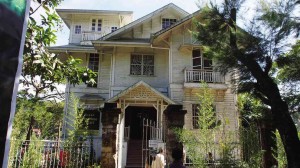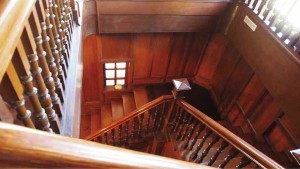Visitors on an otherworldy quest to Baguio City have long made the Laperal House (popularly called the “White House”) on Leonard Wood Road, beside the equally “haunted” Teachers Camp, a required stop. The abode is probably among the most photographed of Baguio’s iconic structures, not only because of its spooky reputation but also by its imposing presence along one of the busiest roads in the city.
Standing enigmatically proud on a three-hectare lot, the mansion was built in the 1920s, the last known owner being the Laperal family.
When Inquirer Property last visited this mansion almost a year ago, Philippine Bamboo Foundation Inc. (PBFI) president Edgardo Manda cheerfully emerged from its front doors, surprising us as the host of an ongoing exhibit held right inside the “hallowed” halls of the house.
We could almost hear Manda naughtily whispering “Bam-BOO!” to us when he began to explain why PBFI decided to house its bamboo exhibit here.
PBFI, he began, is a “nongovernment organization that hosts the biggest bamboo nursery for the entire Visayas and Mindanao, with at least 40 bamboo species grown in the nursery site in Dauin, Negros Oriental.” Among PBFI’s avid supporters is renowned architect and urban planner Felino “Jun” Palafox, an advocate of using indigenous materials for Philippine housing and who has been in close contact with Manda.
Exhibit and museum
The Laperal House is currently owned by the Tan Yan Kee Foundation of the Lucio Tan Group, according to Manda. He added that the house is being maintained by PBFI on an ex-deal arrangement. The foundation uses the house as an exhibit of bamboo art, and as a museum—the grounds are planted with different species of bamboo for landscaping—to educate visitors about the different kinds of this durable, versatile and fast-growing grass.
With its two floors and an attic, the house is estimated to have a per-level area of 150 square meters.
“When we moved in three years ago, the place was minded by a caretaker and a security guard. There were no renovations being done,” Manda told Inquirer Property.
“I was looking for a place in Baguio to exhibit the bamboo carvings done by Ifugao carvers, and one day, as I was passing by the White House, I started asking around about the house, and how to contact the person in charge. Because of its popularity as a haunted house, and as it has not been opened to the public for many years, I thought people would be attracted to it if it would be opened using bamboo art as a reason for its public viewing,” he narrated.
Manda said he was able to contact Leo Pugal, the person in charge of the house. Manda and Pugal came up with an agreement for the use of the house as a bamboo art exhibit and museum, with certain conditions. PBFI was able to move in at the last quarter of 2011, and converted the place into an exhibit area with special lighting. As per the agreement with Pugal, Manda’s group cannot change anything about the house.
Manda said: “With the house’s popularity, combined with the bamboo exhibit, I expected people to become curious and visit the place. Then, I used bamboo art to segue to environmental protection whenever we conducted a guided tour of the place. In fact, grade school students come here for their educational tours. For instance, St. Louis University students regularly go on field trips here to educate its students about the Ifugao bamboo art and the bamboo advocacy.”
Manda doesn’t attempt to hide the place’s other “mysterious” attraction. “Of course, the students are always fascinated by ghosts, so that adds to the motivation to go here,” he said with a chuckle.
Manda disclosed that, predictably, the peak seasons for the exhibits have been the All Saints/All Souls days, Christmas season, Panagbenga festival, Holy Week and summer months, with the average number of visitors at 150 per day. At one point, Manda could be hosting up to 400 visitors a day.
And he reiterated that he doesn’t treat the house’s “invisible residents” with disrespect, urging our group to observe silence and proper decorum while inside the Laperal property.
After our group visited the second floor, a noisy group came up and immediately went down because they said the rooms were locked. But we distinctly remembered that we left all the doors ajar before we came down. No one was left when we came down.
THE BAMBOO exhibit is tastefully placed on strategic locations with no alterations done on the house itself.
“Given the right iconic and mysterious venue, you can attract people to visit a place for your own advocacies, Manda said. “With our discovery of a place for our bamboo carvings, we were able to attract the attention of people from various sectors to take interest and a closer look at our bamboo advocacy, perhaps an innovative way of explaining the importance of environmental protection,” he added.
Scarcity of supply
The Department of Trade and Industry revealed during the National Bamboo Congress in October 2012 a shortfall of 2.35 million bamboo poles annually to cover the demand for local furniture and the handicraft industry.
Manda said the use of bamboo in the construction of houses has not been as extensive as it should be, because the grass is not recognized as a conventional construction material under the building code. He foresees, however, the rise of bamboo in the property industry as timber becomes even scarcer.
The tall grass can be found everywhere. It is as abundant as it is hardy, a symbol of Filipino resilience. The bamboo sways with the strongest of winds, and bends unbreakable in extreme weather.
Much like the “undying” residents of the Laperal House, the bamboo is an enduring fixture of the Filipinos’ daily lives.



